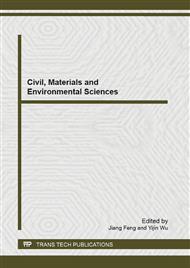[1]
P.I. Glushge: Engineers Digest Vol. 7 (1946), p.330
Google Scholar
[2]
H. Kawano, in: First FIB Congress. (Osaka, 2002).
Google Scholar
[3]
A. Rao, K.N. Jha and S. Misra: Resources, Conservation and Recycling Vol. 50 (2007), p.71
Google Scholar
[4]
EN 1744-5:2007. Tests for chemical properties of aggregates - Part 5: Determination of acid soluble chloride salts.
Google Scholar
[5]
EN 1744-6:2007. Tests for chemical properties of aggregates - Part 6: Determination of the influence of recycled aggregate extract on the initial setting time of cement.
DOI: 10.3403/30088153u
Google Scholar
[6]
EN 1367-1:2008.Tests for thermal and weathering properties of aggregates - Part 1: Determination of resistance to freezing and thawing.
DOI: 10.3403/30077118
Google Scholar
[7]
EN 1367-2:2010. Tests for thermal and weathering properties of aggregates - Part 2: Magnesium sulfate test.
Google Scholar
[8]
J. Karlsen, G. Petkovic and O. Lahus, in: Third International Conference on Sustainable Buildings. (Oslo, 2002).
Google Scholar
[9]
J. Vincke and E. Rousseau, in: Proceedings of the Third International RILEM Symposium on Demolition and reuse of concrete and masonry. (London, 1994).
Google Scholar
[10]
B. Schouenborg, in: Seventh International Conference on the Bearing capacity of roads, railways and airfields. (Trondheim, 2005).
Google Scholar
[11]
B. Schouenborg, J. Aurstad and P. Pétursson, in: Conference on the use of recycled materials in building and structures. (Barcelona, 2004).
Google Scholar
[12]
Commonwealth Scientific and Industrial Research Organization: Guidance on the preparation of non-structural concrete made from RC aggregate (Australia 1998).
Google Scholar
[13]
Commonwealth Scientific and Industrial Research Organization: Guide to the use of recycled concrete and masonry materials (HB 155-2002) (Australia 2002).
Google Scholar
[14]
PTV 406:2003. Recycled aggregates from construction and demolition waste - Technical prescriptions-.
Google Scholar
[15]
NBN B 15001:2012. Concrete - Specification, performance, production and conformity - National supplement to NBN EN 206-1:2001.
Google Scholar
[16]
NBR 15116:2004. Recycled aggregate of solid residue of building constructions - Requirements and methodologies-
Google Scholar
[17]
DIN 4226-100:2002. Aggregates for mortar and concrete – Part 100: recycled aggregates
Google Scholar
[18]
DAfStb: Guideline, concrete with recycled aggregates (Germany 1998).
Google Scholar
[19]
Works Bureau. Technical Circular 12/2002. Specifications facilitating the use of recycled aggregates
Google Scholar
[20]
JIS A 5021:2011. Recycled aggregate for concrete-class H
Google Scholar
[21]
JIS A 5022:2012. Recycled concrete using recycled aggregate class M
Google Scholar
[22]
JIS A 5023:2012. Recycled concrete using recycled aggregate Class L
Google Scholar
[23]
NEN 5905:2010. Dutch supplement to NEN-EN 12620+A1 Aggregates for concrete
Google Scholar
[24]
CUR-Recommendation 4. Crushed concrete as aggregate for concrete (Netherlands, 1984).
Google Scholar
[25]
CUR-Recommendation 5. Crushed masonry as aggregate for concrete (Netherlands, 1984).
Google Scholar
[26]
CUR-Report 125. Crushed concrete rubble and masonry rubble as aggregate for concrete (Netherlands, 1986).
Google Scholar
[27]
NCA-Publication 26. Recycling of material from concrete and bricks for use in production of concrete (Norway, 2003)
Google Scholar
[28]
G. Petkovic and B. Lillestøl: RESIBA report: Material properties of recycled concrete aggregate (Norway 2002)
Google Scholar
[29]
O. Skytterholm and J. Mehus: RESIBA-project report Guidelines for the use of recycled concrete aggregate (Norway 2002)
Google Scholar
[30]
E 471:2006. Guide for the use of recycled coarse aggregates in concretes with hydraulic binder.
Google Scholar
[31]
RILEM TC 121-DRG: Materials and Structures Vol. 27 (1994), p.557
Google Scholar
[32]
RD 1247/2008. Instrucción de Hormigón Estructural EHE-08.
Google Scholar
[33]
GERD: Spanish guide to recycled aggregates from C&D waste (Fueyo Editores, Madrid 2012).
Google Scholar
[34]
OT 70085:2006. Use of secondary mineral building materials in construction
Google Scholar
[35]
SIA 162/4:1994. Recycled concrete
Google Scholar
[36]
BS 8500-2:2006+A1:2012. Complementary British standard to BS EN 206-1. Specification for constituent materials and concrete.
DOI: 10.3403/30371365
Google Scholar
[37]
BRE-Digest 433. Recycled aggregates (UK, 1998).
Google Scholar


